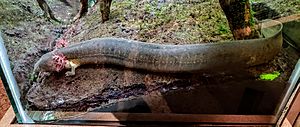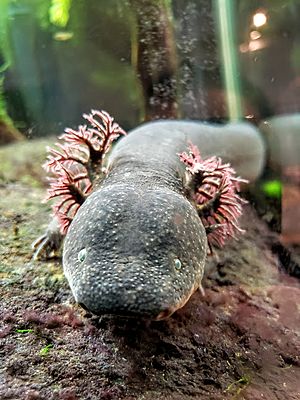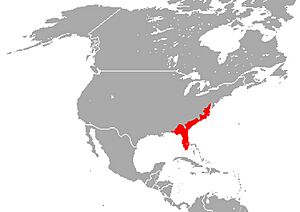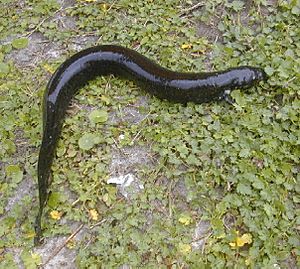Greater siren facts for kids
Quick facts for kids Greater siren |
|
|---|---|
 |
|
 |
|
| Conservation status | |
| Scientific classification | |
| Genus: |
Siren
|
| Species: |
lacertina
|
 |
|
The greater siren (Siren lacertina) is a fascinating amphibian that lives in the water. It's one of five types of animals in the Siren family. This creature is the biggest of the sirens and one of the largest amphibians found in North America. You can find greater sirens living in the wet, swampy areas along the coast of the southeastern United States.
Contents
What is a Greater Siren?
The greater siren is the third longest salamander in the Western Hemisphere. These animals are special because they are paedomorphic. This means they keep some of their baby features, like external gills, even when they are adults. They don't have back legs or eyelids, and their front legs are very small.
Physical Features
When they first hatch, greater sirens are only about 1.5 centimeters (0.6 inches) long. But they can grow much bigger, reaching lengths from 18 to 97 centimeters (7 to 38 inches)! They can weigh anywhere from 55 to 1,000 grams (1.9 to 35 ounces). Their color usually ranges from olive green to gray, often with small yellow or green dots on their sides. Younger sirens have a light stripe along their sides, which fades as they get older.
How Sirens Sense the World
Greater sirens have very small eyes, so they don't rely on sight much. Instead, they use special organs to sense their surroundings. They have a modified Jacobson's organ, which helps them smell things in the water. They also use a lateral line system, which helps them feel movements and vibrations in the water around them. Scientists even think they might be able to sense changes in electrical fields!
What Greater Sirens Eat
Greater sirens are carnivores, meaning they eat other animals. They hunt for small creatures like insects, crustaceans (like crayfish), snails, and clams. They also eat small fish. While they mostly eat animals, they have been seen eating plants like algae too.
Greater sirens have tiny teeth that help them grab their prey. However, these teeth don't really chew or grind food. They swallow their food whole. This means that if they eat a snail, they swallow the whole shell!
Life and Habits of the Greater Siren
Greater sirens are important in their watery homes. They are considered "mid-level predators," meaning they eat smaller creatures and are, in turn, eaten by larger ones.
Daily Life and Lifespan
These animals are nocturnal, which means they are most active at night. During the day, they hide in thick plants to stay safe. We don't know exactly how long they live in the wild. But in zoos or special care, they can live for up to 25 years!
Special Abilities
Greater sirens can make sounds, like clicks or yelps. These sounds are similar to the calls of the American green tree frog. They also have an amazing ability called aestivation. If their pond or swamp dries up, they can burrow into the mud and create a cocoon from their own skin. They can stay like this for a long time, even up to three years, waiting for water to return! They can also breathe in three ways: through their gills, through their skin, and with small lungs.
Predators
Some animals that hunt and eat greater sirens include the American alligator and the mud snake. Scientists have also seen a two-toed amphiuma eat a greater siren, so that's another known predator.
Reproduction and Life Cycle
Greater sirens have an interesting way of reproducing. We don't know much about how they find partners, but mating happens in February and March.
Laying Eggs and Raising Young
A female greater siren can lay about 500 eggs at once! After the eggs are laid, the father siren takes over. He will fan his tail over the nest, which might help keep the eggs healthy. The father is very protective and will guard the nest fiercely from other sirens, even the mother! After about two months, the eggs hatch. Once the babies are born, the father leaves the nest. Young sirens live in shallower water than the adults, often hiding among the roots of plants like water hyacinths.
Where Greater Sirens Live
Greater sirens live in the wet, coastal areas from Washington, D.C. down to Florida and Alabama. There was once a thought that they lived in the Rio Grande area in Texas and Mexico, but newer studies have shown this is not true.
Preferred Habitat
These amphibians love wetlands, especially places where the water moves slowly or not at all. They like areas with a lot of organic material, like decaying leaves and plants, at the bottom. Because they can aestivate, they can live in wetlands that sometimes dry up. If the water disappears, they simply burrow into the mud. They are often found in the deep parts of the water where there are lots of aquatic insects to eat. They also like to hide under logs and other things during the day to stay safe from predators.
How Scientists Study Greater Sirens
It can be tricky for scientists to catch greater sirens because they live in places with lots of thick plants. Regular ways of catching water animals don't work well there.
Trapping Techniques
Scientists have found that special aquatic funnel traps, which are also used for catching crayfish, work well for sirens. These traps are safe for the animals. Each trap has a body, three funnels, and a lid at the top. This design helps scientists study these amazing creatures without harming them.
Protecting Greater Sirens
The International Union for Conservation of Nature says that greater sirens are a "Least Concern" animal. This means they are not currently in danger of disappearing. However, they have disappeared from some areas where they used to live because their homes (habitats) have been lost. In Mexico, they are protected by law and are in a "Special Protection" category.
Images for kids
See also
 In Spanish: Sirena mayor para niños
In Spanish: Sirena mayor para niños






